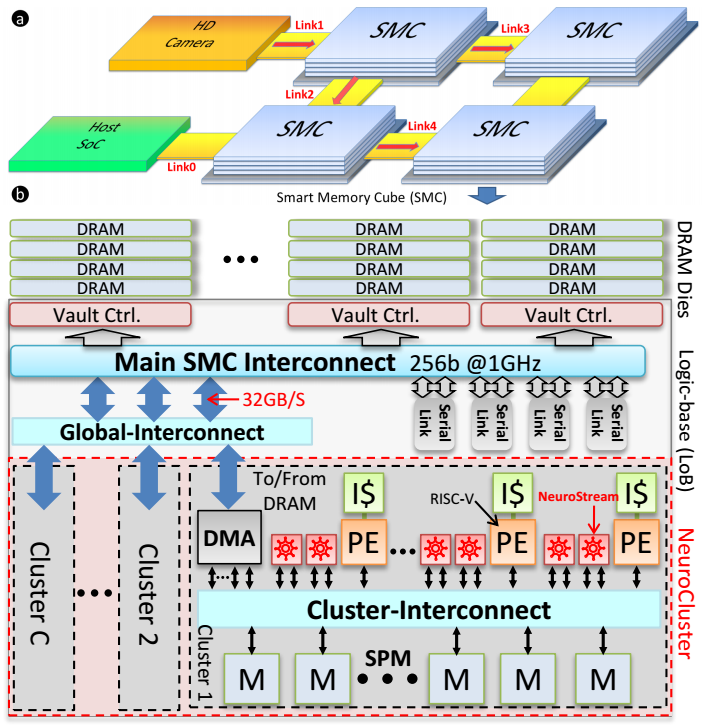Neurostream - a new chip for deep learning
High-performance computing systems are already being used for high-bandwidth memory (HBM) and Hybrid Memory Cube (HMC) technology. In this direction are actively being developed.
Scientists from the University of Bologna at the end of January presented an architecture for computation in memory (PIM) that can work effectively with deep convolutional neural networks. She received the name of Neurostream.
 / photo by Ryan McMinds CC
/ photo by Ryan McMinds CC
')
The design is based on a promising type of computer memory HMC (Hybrid Memory Cube), which in the framework of the project was named Smart Memory Cube, or SMC. The solution is complemented by a multi-core NeuroCluster PIM platform.
NeuroCluster has a modular design based on NeuroStream and RISC-V floating-point coprocessors. Interestingly, only 8% of HMC crystals are used to achieve a performance of 240 gigaflops with a power consumption of 2.5 watts.
"Cubes of memory" have a very low power consumption, but they are able to cope with the tasks for convolutional networks, the article says scientists from the university. “This allows you to free up computer logic resources to handle other workloads.”
A small increase in system power consumption and a slight increase in space occupied by scaling make this PIM system cost-and energy-efficient, which can be easily expanded to 955 gigaflops when four SMCs are turned on.
Scientists compared the capabilities of the new solution with the computing power of the GPU Nvidia Tesla K40. The Tesla K40 was able to realize 1092 gigaflops with a power consumption of 235 watts. NeuroGrid technology has reached 955 gigaflops with a power of 42.8 watts - energy efficiency is 4.8 times higher than that of a GPU.
 Image : SMC network and block diagram of one of the “cubes”
Image : SMC network and block diagram of one of the “cubes”
Moreover, the creators of Neurostream expect that energy efficiency can be improved by using software solutions, as well as performing arithmetic operations of reduced accuracy. According to scientists, this can reduce energy consumption by 70%. More information about the decision can be found in the article by the staff of the University of Bologna.
Further, in their work, the researchers plan to explore the possibilities of implementing a system with four NeuroCluster units that will be used to monitor the learning process of networks.
PS But what else do we write in the blog of our project 1cloud:
Scientists from the University of Bologna at the end of January presented an architecture for computation in memory (PIM) that can work effectively with deep convolutional neural networks. She received the name of Neurostream.
 / photo by Ryan McMinds CC
/ photo by Ryan McMinds CC')
The design is based on a promising type of computer memory HMC (Hybrid Memory Cube), which in the framework of the project was named Smart Memory Cube, or SMC. The solution is complemented by a multi-core NeuroCluster PIM platform.
NeuroCluster has a modular design based on NeuroStream and RISC-V floating-point coprocessors. Interestingly, only 8% of HMC crystals are used to achieve a performance of 240 gigaflops with a power consumption of 2.5 watts.
"Cubes of memory" have a very low power consumption, but they are able to cope with the tasks for convolutional networks, the article says scientists from the university. “This allows you to free up computer logic resources to handle other workloads.”
A small increase in system power consumption and a slight increase in space occupied by scaling make this PIM system cost-and energy-efficient, which can be easily expanded to 955 gigaflops when four SMCs are turned on.
Scientists compared the capabilities of the new solution with the computing power of the GPU Nvidia Tesla K40. The Tesla K40 was able to realize 1092 gigaflops with a power consumption of 235 watts. NeuroGrid technology has reached 955 gigaflops with a power of 42.8 watts - energy efficiency is 4.8 times higher than that of a GPU.

Moreover, the creators of Neurostream expect that energy efficiency can be improved by using software solutions, as well as performing arithmetic operations of reduced accuracy. According to scientists, this can reduce energy consumption by 70%. More information about the decision can be found in the article by the staff of the University of Bologna.
Further, in their work, the researchers plan to explore the possibilities of implementing a system with four NeuroCluster units that will be used to monitor the learning process of networks.
PS But what else do we write in the blog of our project 1cloud:
- How neural networks are now used: from research projects to entertainment services
- A bit about VPN: A brief overview of software implementations
- How to secure a Linux system: 10 tips
- A selection of materials about clouds, data centers and the development of services
- How to find out what an SSL certificate consists of?
- Cloud Security Trends
Source: https://habr.com/ru/post/321304/
All Articles